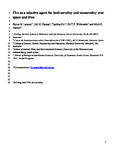Fire as a Selective Agent for both Serotiny and Nonserotiny Over Space and Time
| dc.contributor.author | Lamont, BB | |
| dc.contributor.author | Pausas, JG | |
| dc.contributor.author | He, T | |
| dc.contributor.author | Witkowski, ETF | |
| dc.contributor.author | Furtado Frota, Francisco Gabriel | |
| dc.date.accessioned | 2020-09-15T06:32:30Z | |
| dc.date.available | 2020-09-15T06:32:30Z | |
| dc.date.issued | 2020-03-03 | |
| dc.identifier.issn | 0735-2689 | |
| dc.identifier.issn | 1549-7836 | |
| dc.identifier.uri | http://hdl.handle.net/10026.1/16249 | |
| dc.description | Acceptance date approximate as author was not able to supply. | |
| dc.description.abstract |
Serotiny is the prolonged storage of seeds in closed cones or fruits held within the crown of woody plants. It is widespread throughout fireprone vegetation with a predominantly winter rainfall, especially in Mediterrnanean-type ecosystems (MTEs). Nonstorage is a feature of fireprone vegetation with summer-dominant rainfall or nonfireprone vegetation. Serotiny confers fitness benefits on an individual when fire return intervals fall between age to reproductive maturity and the plant life span. The level of serotiny within and between species varies greatly along a continuum indicating highly plastic responses to different environmental conditions. Here we review how and why the traits that underpin this reproductive syndrome evolved and continue to control the occurrence of species in contemporary landscapes. We documented 1345 serotinous species in fireprone regions of Australia, South Africa, the Mediterranean Basin, North America, and Asia. The length of seed storage varies from a few years (weak serotiny) to >10 years (strong serotiny), with remarkable diversity even within clades. We show how the interplay between postfire and interfire seedling recruitment dictates the expression of serotiny along a strong serotiny/nonserotiny continuum, and that, where strong serotiny is favored, the ‘gene support for serotiny’ builds up over successive generations. Nonserotiny is favored in the absence of fire or occurs at intervals exceeding plant longevity, but also when the fire is so frequent that only resprouters can survive. We identify 23 traits associated with serotiny/nonserotiny syndromes that are subject to both environmental and phylogenetic constraints. While all are coordinated for maximum fitness, some traits, such as protection from granivores, are only indirectly related to the fire regime. Serotiny has a long history extending back to the Triassic. The rate of serotinous-lineage proliferation has fluctuated greatly over time but peaked over the last 5 million years. Nonserotinous species have evolved from serotinous ancestors in response to increased fire frequency, or as plants migrated to fire-free habitats. We note that contemporary shifts in climate, land-use, and exploitation have had a profound, but disproportionate, effect on the conservation status and evolutionary trajectory of serotinous species in MTEs. Escalating anthropogenic impacts increase the need to understand how and why serotiny is such a prominent feature of some fireprone ecosystems. We highlight avenues for future research and argue for the use of temporally based measures of serotiny to facilitate comparisons between studies. | |
| dc.format.extent | 140-172 | |
| dc.language | en | |
| dc.language.iso | en | |
| dc.publisher | Informa UK Limited | |
| dc.subject | Banksia | |
| dc.subject | canopy seed storage | |
| dc.subject | fire ecology | |
| dc.subject | flammability | |
| dc.subject | Hakea | |
| dc.subject | interfire | |
| dc.subject | Mediterranean | |
| dc.subject | Pinus | |
| dc.subject | postfire recruitment | |
| dc.subject | Protea | |
| dc.subject | resprouters | |
| dc.subject | savanna | |
| dc.subject | seedlings | |
| dc.subject | seed storage | |
| dc.subject | woody fruits | |
| dc.title | Fire as a Selective Agent for both Serotiny and Nonserotiny Over Space and Time | |
| dc.type | journal-article | |
| dc.type | Journal Article | |
| plymouth.author-url | https://www.webofscience.com/api/gateway?GWVersion=2&SrcApp=PARTNER_APP&SrcAuth=LinksAMR&KeyUT=WOS:000549899600003&DestLinkType=FullRecord&DestApp=ALL_WOS&UsrCustomerID=11bb513d99f797142bcfeffcc58ea008 | |
| plymouth.issue | 2 | |
| plymouth.volume | 39 | |
| plymouth.publication-status | Published | |
| plymouth.journal | Critical Reviews in Plant Sciences | |
| dc.identifier.doi | 10.1080/07352689.2020.1768465 | |
| plymouth.organisational-group | /Plymouth | |
| plymouth.organisational-group | /Plymouth/Faculty of Science and Engineering | |
| plymouth.organisational-group | /Plymouth/Faculty of Science and Engineering/School of Biological and Marine Sciences | |
| plymouth.organisational-group | /Plymouth/REF 2021 Researchers by UoA | |
| plymouth.organisational-group | /Plymouth/REF 2021 Researchers by UoA/UoA06 Agriculture, Veterinary and Food Science | |
| plymouth.organisational-group | /Plymouth/Users by role | |
| plymouth.organisational-group | /Plymouth/Users by role/Academics | |
| dcterms.dateAccepted | 2020-03-01 | |
| dc.rights.embargodate | 2021-3-3 | |
| dc.identifier.eissn | 1549-7836 | |
| dc.rights.embargoperiod | Not known | |
| rioxxterms.versionofrecord | 10.1080/07352689.2020.1768465 | |
| rioxxterms.licenseref.uri | http://www.rioxx.net/licenses/all-rights-reserved | |
| rioxxterms.licenseref.startdate | 2020-03-03 | |
| rioxxterms.type | Journal Article/Review |


